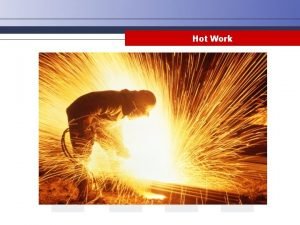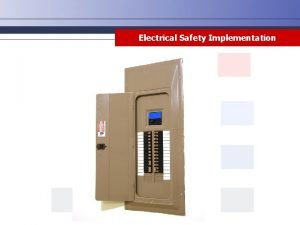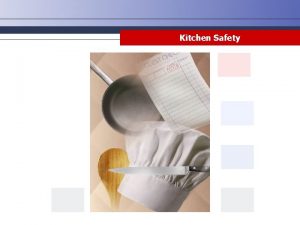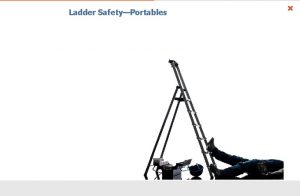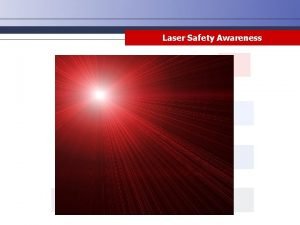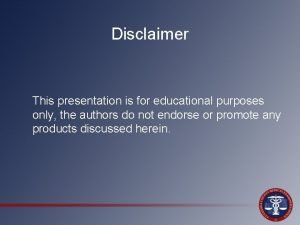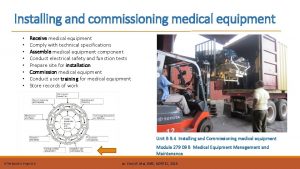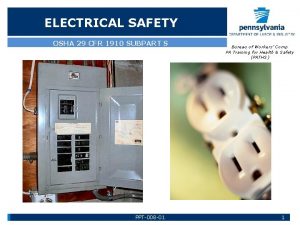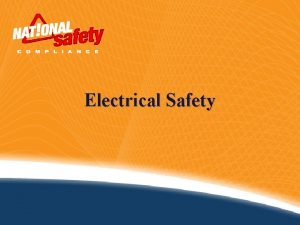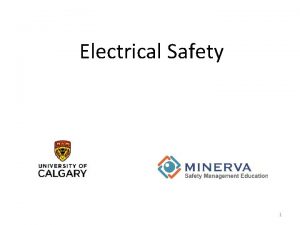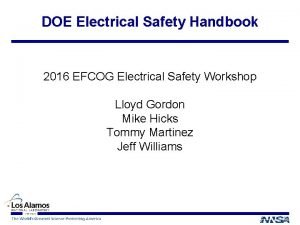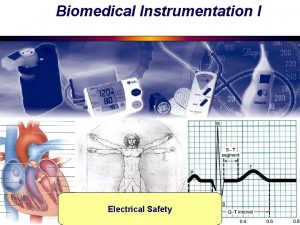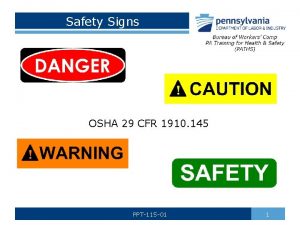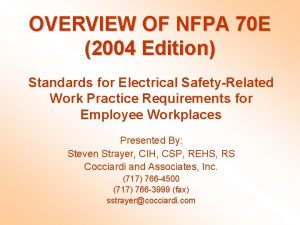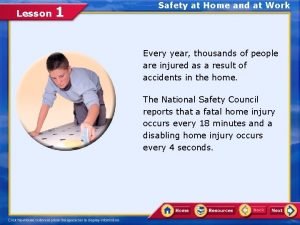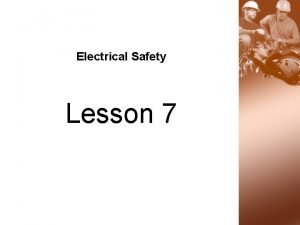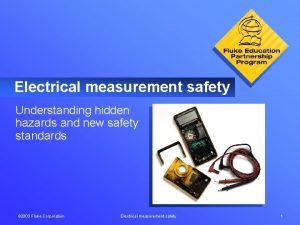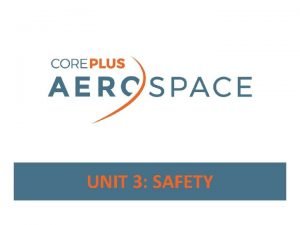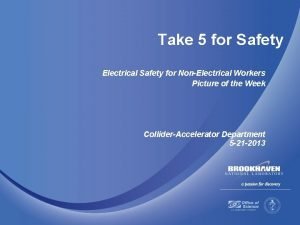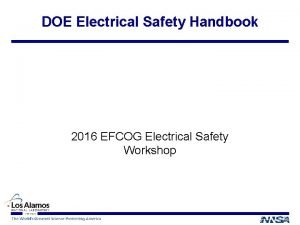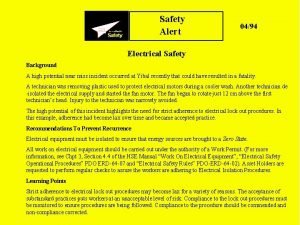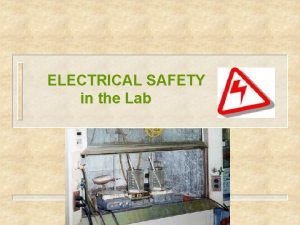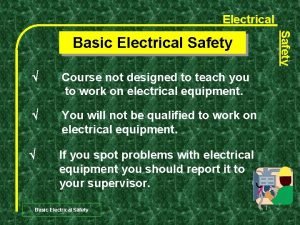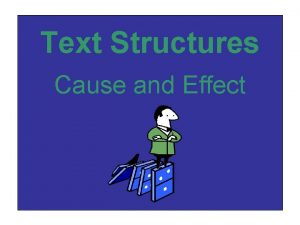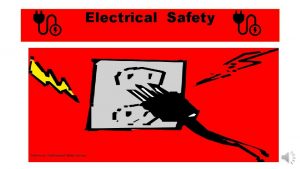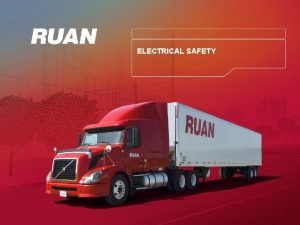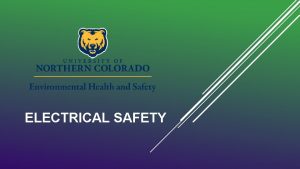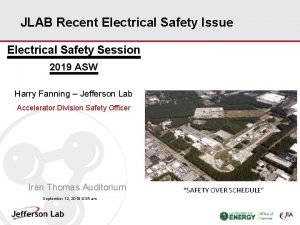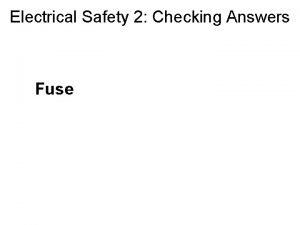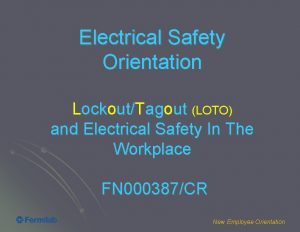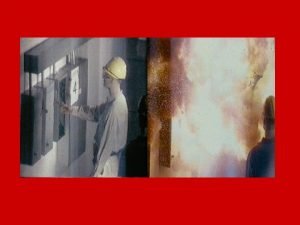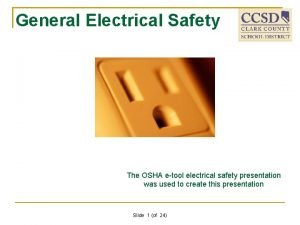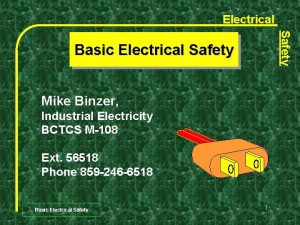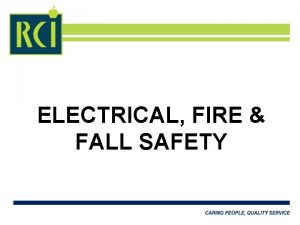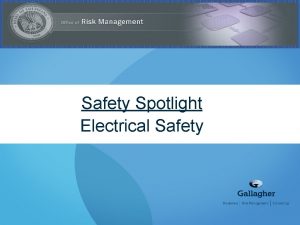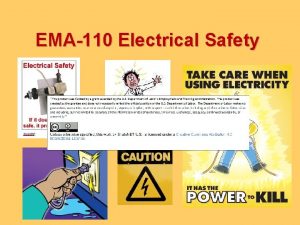Electrical Safety Implementation Disclaimer This training material presents










































- Slides: 42

Electrical Safety Implementation

Disclaimer • This training material presents very important information. • Your organization must do an evaluation of all exposures, applicable codes and regulations, and establish proper controls, training, and protective measures to effectively control exposures and assure compliance. • This program is neither a determination that the conditions and practices of your organization are safe nor a warranty that reliance upon this program will prevent accidents and losses or satisfy local, state or federal regulations. • All procedures and training, whether required by law or not, should be implemented and reviewed by safety and risk management professionals, and legal counsel to ensure that all local, state and federal requirements are satisfied.

Course Outline – Electrical Safety Implementation 1. 2. 3. 4. 5. 6. Why Take Electrical Safety Implementation Training? Background Hazardous Locations Wiring Protection and Grounding Workspace Cord and Plug Equipment

Why Do Electrical Safety Training? Fed-OSHA adopted the components of NFPA 70 E in 2007: • This is for electrical installations (engineering controls) for workplace electrical hazards. • This was the first revision to 29 CFR Subpart S standard in over 25 years. • It is important that companies are aware of changes for OSHA compliance and worker safety.

Background Best practices: • Electrical installations: Covers electrical engineering controls to prevent inadvertent shock to the worker. • Work practices: Covers the means to protect workers during energized work. This includes personal protective equipment, approach boundaries, tools, and awareness means.

Hazardous Locations Classification of environments: • The National Electrical Code (NEC) defines hazardous locations as those areas "where fire or explosion hazards may exist due to flammable gases or vapors, flammable liquids, combustible dust, ignitable fibers or flyings. ” • Classification of these environments is as follows: • Class I-Flammable gases and vapors • Class II-Combustible dusts • Class III-Combustible fibers • 29 CFR 1910. 307 applies to electrical installations after August 2007.

Hazardous Locations Class descriptions: • Class I: Locations where flammable gasses or vapors are or may be present. • Class II: Locations which are hazardous due to the presence of combustible dust. • Class III: Locations which are hazardous due to the presence of easily ignitable fibers.

Hazardous Locations Class Division 1 Division 2 I Locations where hazardous concentrations are probable. Locations where flammable concentrations are possible, but only in the event of process failures, ruptures, etc. II Locations where hazardous concentrations are probable. Locations where flammable concentrations are possible, but only in the event of a process failure. III Locations where easily ignitable fibers or materials which produce combustible fibers are handled, manufactured or used. Locations where combustible fibers are stored.

Hazardous Locations Class I examples: • Areas where flammable liquids are transferred from one container to another. • Interior areas that are adjacent to paint spray booths. • Drying rooms for flammable liquids. Paint spray booths are usually classified as Class I, Division 1.

Hazardous Locations Class I, Division 2: • A flammable mixture in an adequately ventilated area and only likely to leak through faulty gaskets or packaging. • A flammable mixture is present in an inadequately ventilated area and is unlikely to leak. Example: Chemical storage room

Hazardous Locations Zone Description Examples 0 Ignitable concentrations present continuously • Tanks with flammable liquids • Spraying enclosures 1 Ignitable concentrations present intermittently • Flammable liquids transferred from one container to another 2 Ignitable concentrations NOT • Flammable liquids only in the likely to be present under event of an accident or unusual normal operating conditions operating condition In 2007 Divisions were substituted for ZONES.

Hazardous Locations Explosion proof light fixtures:

Hazardous Locations Explosion proof receptacles and light switches:

Hazardous Locations NFPA 30 (Flammable and combustible liquids code): • Electrical utilization equipment and wiring shall not constitute a source of ignition for any ignitable vapor that might be present. (NFPA 30, Section 7. 3)

Hazardous Location NEC Class I Division Extent of Classified Area Zone Indoor equipment installed in accordance with section 7. 3 where flammable vapor–air mixtures can exist under normal operation. 1 0 The entire area associated with such equipment including flammable gases or vapors are present for long periods of time. 1 1 Area within 5 ft of any edge of such equipment extending in all directions. 2 2 Area between 5 ft. and 8 ft. of any edge of equipment, extending in all directions; and up to 3 ft. above floor or grade level within horizontally from any edge of such equipment. Tank storage installations inside of buildings. 1 1 All equipment located below grade level. 2 2 Any equipment located at or above grade level.

Hazardous Locations Review of physical properties of combustible dusts: • For air suspended dust to explode it must be present in quantities at or above the Minimum Explosive Concentration (MEC). • The minimum concentration of dust in air that will explode when ignited, expressed in grams per cubic meter (g/m 3). ‒ ‒ MEC for coal dust is in the range of 60 g/m 3 MEC for aluminum is in the range of 170 g/m 3 MEC for magnesium is in the range of 90 g/m 3 The minimum ignition energy tended to increase with particle size.

Hazardous Locations Standards: • NFPA 499, “Recommended Practice for the Classification of Combustible Dusts and of Hazardous (Classified) Locations for Electrical Installations in Chemical Process Areas”, (2008 Edition) • OSHA Electrical Safety Standard (29 CFR 1910. 307) • NEC (NFPA 70)

Hazardous Locations Non-explosion proof electrical equipment Explosion proof electrical equipment

Hazardous Locations Evaluation for class II classification: Depth of Dust Accumulation <1/32” to 1/8” >1/8” Frequency Housekeeping Requirement Release of dust not more Clean-up during same • than 2 -3 times per year shift Release of dust more than 3 Clean as necessary to • times per year or continuous maintain average release resulting in >1/32” accumulation below 1/64” • in 24 hours Release of dust not more Clean-up during same • than 2 -3 times per year shift • Release of dust more than 3 times per year or continuous release resulting in >1/32” in 24 hours Release of dust not more than 2 -3 times per year Release of dust more than 3 times per year or continuous release resulting in >1/32” in 24 hours Clean as necessary to • maintain average accumulation below 1/64” Immediately shut down and clean Clean at frequency to minimize accumulation Area Classification Unclassified/Electrical enclosures dust tight Need not be Class II in existing applications Unclassified/Electrical enclosures dust tight Need not be Class II in existing applications Class II, Division 2 • Class II, Division 1

Wiring Protection and Design Circuit polarity: • Polarity of connections: Correct polarity between the ungrounded conductor, the grounded conductor, and the grounding conductor must be maintained. • Reverse polarity: This results when the grounded conductor is incorrectly connected to the ungrounded terminal. Circuit testers can be purchased at any home improvement store. They can be used to test correct polarity at most electrical outlets.

Wiring Protection and Design Reverse polarity: • If the hot conductor is reversed with the neutral conductor, the current path downstream is reversed. • Under the conditions of reverse polarity, tools and equipment will be energized even after the equipment is turned off. • Contact with energized parts and any ground will cause a shock. • The only way to turn off the power would be at a fuse or circuit breaker.

Wiring Protection and Design Correct wiring:

Wiring Protection and Design Hot and neutral reversed: • If an internal fault occurs, the equipment would not stop when the switch is released. Or, it would start as soon as the person plugs in the equipment.

Wiring Protection and Design Ground and hot reversed: • Because the equipment is grounded in conjunction with the system ground, the metal case of the equipment may be energized as the hot is energizing what is normally the ground.

Wiring Protection and Design Disconnecting means: • Switch or circuit breaker is capable of interrupting current flow from a supply source. • This will disconnect electrical equipment from its source in the event of an emergency or during normal servicing of operations.

Wiring Protection and Design Disconnect Circuit breaker All disconnecting means must be identified.

Wiring Protection and Design Panel board with marked circuit breakers and legend. Disconnect is marked with service location.

Workspace Requirements: • Suitable access and working space shall be provided around all electrical equipment to permit ready and safe O & M of equipment. • Depth distances shall be maintained from the energized parts if they are normally exposed or from the enclosure or opening if normally enclosed. • Workspace shall be adequate to permit a 90 degree opening of door or hinged parts.

Workspace Proper distance measurements: • Exposed: From the live parts. • Enclosed: From the enclosure front opening.

Workspace Requirements for Low Voltage Equipment

Workspace Condition types: • Condition A: Exposed “live” parts on one side and no live or grounded • Condition B: Exposed “live” parts on one side and grounded parts on the • Condition C: Exposed “live” parts on both sides of the work space (not parts on the other side of the working space, or exposed live parts on both sides effectively guarded by suitable wood or other insulating material. other. Cinderblock and tiled walls are considered grounded surfaces. guarded as provided in Condition A) with the operator between.

Workspace Requirements for High Voltage Equipment

Cord and Plug Equipment Do not: • Yank a cord to disconnect it from its receptacle. • Carry tool by the cord or hose.

Cord and Plug Equipment Flexible cord use permitted: • 29 CFR 1910. 305(g)(1)(i) • Wiring of fixtures • Connection of portable lamps or appliances • Elevator cables • Appliances where the fastening means and mechanical connections are designed to permit removal for maintenance or repair • Pendants • Prevention or transmission of noise and vibration

Cord and Plug Equipment Flexible cord use not permitted: • 29 CFR 1910. 305(g)(1)(ii) • Substitute for fixed wiring • Where run through walls, ceilings or floors • Where run through doorways or windows • Where attached to building surfaces • Where concealed behind building walls, ceilings, or floors

Cord and Plug Equipment Do not duct tape cords: The use of duct tape on cords indicate poor condition and should be removed from operation.

Cord and Plug Equipment Power strip rules: • A heavy reliance on power strips indicates there are not enough outlets in the area. • Power strips plugged into power strips may overload circuits.

Cord and Plug Equipment Circuit breakers: Openings and missing circuit breakers in panel boards.

Cord and Plug Equipment Cord condition: Combination of cords in poor condition may be a hazard.

Cord and Plug Equipment Testing: • • • A continuity tester is used to ensure the grounding conductor is properly intact. Tests to be performed: – Continuity – Correct attachment of the grounding conductor. Tests to be performed at intervals: – Before each use. – Before it is returned to service after repairs. – If there is evidence of damage. – For periods not exceeding 3 months. Do not use extension cords for permanent use (90 day limit).

Summary • Awareness: Be aware of electrical equipment in hazardous locations. • Proper markings: Ensure all electrical equipment is properly marked. • Requirements: Observe workspace requirements. • Inspection: Inspect areas for improper use of cord and plug equipment. • Testing: Purchase testing equipment for continuity testing and outlet circuit testing.

Electrical Safety Implementation This form documents that the training specified above was presented to the listed participants. By signing below, each participant acknowledges receiving this training. Organization: Trainer: Trainer’s Signature: Class Participants: Name: Signature: Date: Name: Signature: Date: Name: Signature: Date: Remember to load your completed trainings into the Risk Management Center.
 Disclaimer for training material
Disclaimer for training material Disclaimer for training material
Disclaimer for training material Disclaimer for training material
Disclaimer for training material Disclaimer for training material
Disclaimer for training material Disclaimer for training material
Disclaimer for training material Safety care training
Safety care training Education purposes only
Education purposes only Disclaimer for educational purposes only
Disclaimer for educational purposes only Tools and materials used in making electrical gadgets
Tools and materials used in making electrical gadgets Project implementation plan template
Project implementation plan template Electrical safety analyzer
Electrical safety analyzer Osha subpart s
Osha subpart s Electrical safety introduction
Electrical safety introduction Electrical safety introduction
Electrical safety introduction Doe electrical safety handbook
Doe electrical safety handbook Electrical safety in biomedical instrumentation
Electrical safety in biomedical instrumentation What three elements are required for all electric circuits
What three elements are required for all electric circuits Electrical safety case study answers
Electrical safety case study answers Industrial safety signs and symbols ppt
Industrial safety signs and symbols ppt Nfpa 70e 2004 standard for electrical safety
Nfpa 70e 2004 standard for electrical safety Lesson 1 electrical safety culture
Lesson 1 electrical safety culture Electrical safety worksheet answers
Electrical safety worksheet answers Fluke electrical measurement safety
Fluke electrical measurement safety Lesson 1: electrical safety culture
Lesson 1: electrical safety culture Take 5 electrical safety
Take 5 electrical safety Doe electrical safety handbook
Doe electrical safety handbook Electrical safety alert
Electrical safety alert Electrical lab safety
Electrical lab safety Basic electrical safety
Basic electrical safety Coning of rails
Coning of rails Maximum material condition and least material condition
Maximum material condition and least material condition Rsq in standard costing
Rsq in standard costing Material culture examples
Material culture examples Material and non material culture examples
Material and non material culture examples Examples of non material culture
Examples of non material culture Examples of materials that are useful and harmful
Examples of materials that are useful and harmful The safest ladder to use around electricity is
The safest ladder to use around electricity is It presents cause-effect relationships
It presents cause-effect relationships Presents from my aunt in pakistan
Presents from my aunt in pakistan Pear paragraph example
Pear paragraph example Business agility metrics
Business agility metrics 16 3 darwin presents his case answer key
16 3 darwin presents his case answer key Section 15-3 darwin presents his case
Section 15-3 darwin presents his case
